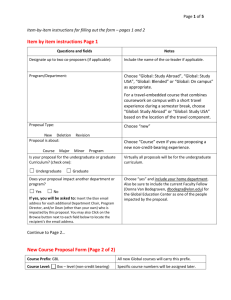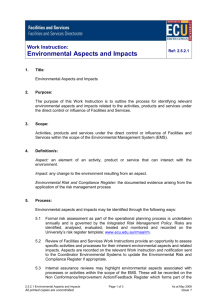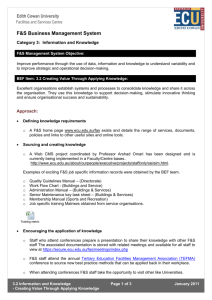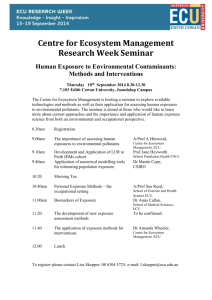On-Campus/Off-Campus Determination
advertisement
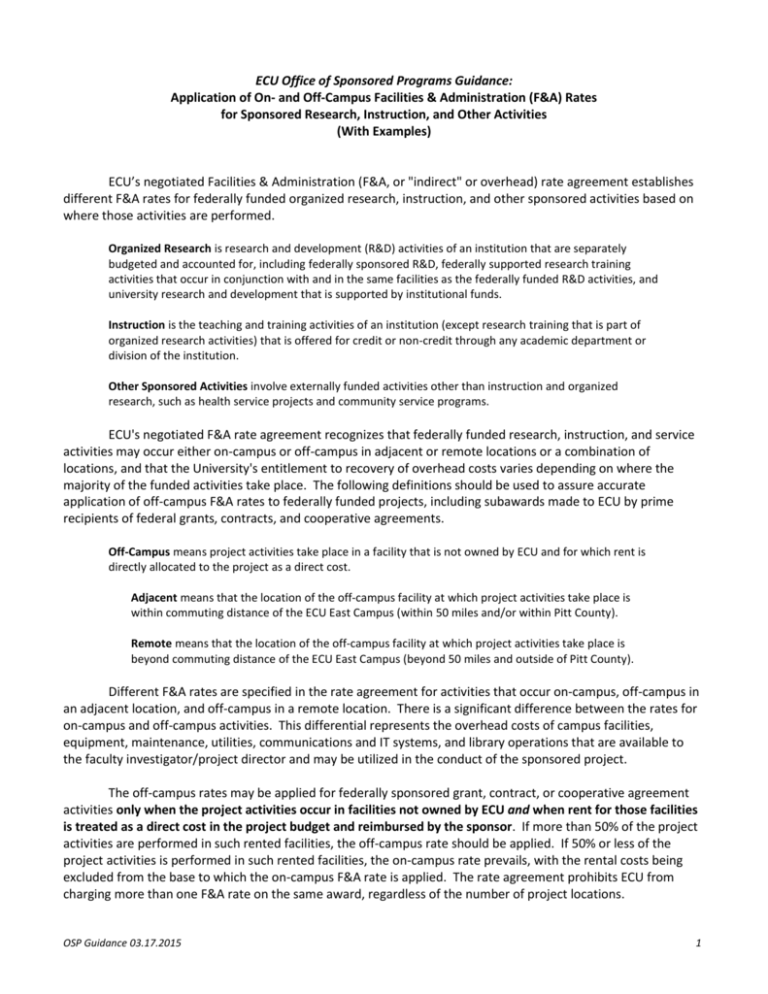
ECU Office of Sponsored Programs Guidance: Application of On- and Off-Campus Facilities & Administration (F&A) Rates for Sponsored Research, Instruction, and Other Activities (With Examples) ECU’s negotiated Facilities & Administration (F&A, or "indirect" or overhead) rate agreement establishes different F&A rates for federally funded organized research, instruction, and other sponsored activities based on where those activities are performed. Organized Research is research and development (R&D) activities of an institution that are separately budgeted and accounted for, including federally sponsored R&D, federally supported research training activities that occur in conjunction with and in the same facilities as the federally funded R&D activities, and university research and development that is supported by institutional funds. Instruction is the teaching and training activities of an institution (except research training that is part of organized research activities) that is offered for credit or non-credit through any academic department or division of the institution. Other Sponsored Activities involve externally funded activities other than instruction and organized research, such as health service projects and community service programs. ECU's negotiated F&A rate agreement recognizes that federally funded research, instruction, and service activities may occur either on-campus or off-campus in adjacent or remote locations or a combination of locations, and that the University's entitlement to recovery of overhead costs varies depending on where the majority of the funded activities take place. The following definitions should be used to assure accurate application of off-campus F&A rates to federally funded projects, including subawards made to ECU by prime recipients of federal grants, contracts, and cooperative agreements. Off-Campus means project activities take place in a facility that is not owned by ECU and for which rent is directly allocated to the project as a direct cost. Adjacent means that the location of the off-campus facility at which project activities take place is within commuting distance of the ECU East Campus (within 50 miles and/or within Pitt County). Remote means that the location of the off-campus facility at which project activities take place is beyond commuting distance of the ECU East Campus (beyond 50 miles and outside of Pitt County). Different F&A rates are specified in the rate agreement for activities that occur on-campus, off-campus in an adjacent location, and off-campus in a remote location. There is a significant difference between the rates for on-campus and off-campus activities. This differential represents the overhead costs of campus facilities, equipment, maintenance, utilities, communications and IT systems, and library operations that are available to the faculty investigator/project director and may be utilized in the conduct of the sponsored project. The off-campus rates may be applied for federally sponsored grant, contract, or cooperative agreement activities only when the project activities occur in facilities not owned by ECU and when rent for those facilities is treated as a direct cost in the project budget and reimbursed by the sponsor. If more than 50% of the project activities are performed in such rented facilities, the off-campus rate should be applied. If 50% or less of the project activities is performed in such rented facilities, the on-campus rate prevails, with the rental costs being excluded from the base to which the on-campus F&A rate is applied. The rate agreement prohibits ECU from charging more than one F&A rate on the same award, regardless of the number of project locations. OSP Guidance 03.17.2015 1 Routine field work, such as data and sample collection for environmental research, collection of observational data in local public schools for educational research, or manuscript review at an out-of-state library for historical research, does not constitute off-campus research. The PI/PD typically returns to campus where university infrastructure and resources are available to support other project activities such as analyzing samples and data, conducting experiments, and preparing reports and manuscripts, entitling the University to collect F&A to cover facilities costs. Special Note: Although geographically separate, the Coastal Studies Institute (CSI) facilities are designated as on-campus for F&A rate application purposes. Although F&A rates are federally negotiated, ECU applies these rates to all sponsored activity, regardless of sponsor type. Thus, the appropriate federally negotiated F&A rate should be applied to all sponsored projects based on performance location unless the sponsor has a published policy that limits F&A recovery (e.g., the 8% training limit applied by some agencies). In particular, full F&A must be included in research proposals for business and industry sponsors. Fixed price agreements with these business and industry sponsors that are based on fully burdened costs may be particularly appropriate. Researchers are strongly encouraged to consult with OSP staff prior to initiating or participating in any discussions of project cost with for-profit sponsors to ensure appropriate project costing. Requests to apply an off-campus F&A rate for projects that do not meet the federal definition of "offcampus" in ECU's F&A rate agreement may be made during proposal development through the University's established F&A waiver process (see "Distribution of F&A Recoveries [Overhead Proceeds]" Standard Operating Procedure). The PI/PD should clearly explain the nature, location, and duration of the off-campus work and its proportion of the total project. Details of ownership any off-campus facilities to be utilized and rental or use agreements for those facilities should also be included. (Note that hotel sleeping rooms and rented residential space when an individual is in travel status are not considered off-campus facilities.) Determining the applicable F&A rate can be challenging, depending on the circumstances of the proposed project. The examples below provide additional guidance for--and illustrate some of the complexities of-selecting the appropriate F&A rate. The Office of Sponsored Programs is available to assist investigators in selection of the appropriate rate. Investigators who wish to apply an off-campus rate based on reasonable justification when the Federal definition of off-campus is not satisfied are encouraged to submit their proposal and F&A waiver request well ahead of the proposal deadline to accommodate review of the request and action by the Associate Vice Chancellor for Research. EXAMPLES: 1. Dr. Zee is seeking funding from the Department of Defense for a twelve month pilot study to investigate a new intensive therapy treatment for traumatic brain injury. He will recruit veterans for the study at the local VA facility where he will have access to a small therapy room and office at no cost. He will conduct treatment interventions and collect data, using his ECU laptop computer, in these facilities four mornings a week for nine months. When data collection is complete, Dr. Zee will use the ECU-licensed SAS software on his office computer in his West Campus office to analyze the data. He estimates he will spend about 240 hours doing the statistical analyses and interpretations. However, he expects to do most of his technical report writing and manuscript preparation on his home computer on Saturdays and Sundays. What is the applicable F&A rate for Dr. Zee's project? Answer: On-Campus. Although Dr. Zee plans to spend a significant amount of time at the VA clinic providing experimental therapy and collecting data and comparatively little time in his office crunching OSP Guidance 03.17.2015 2 data, there is no rental charge for the space he will be using at the VA. Work undertaken at home using personal equipment has no bearing on applicable F&A rates. Therefore, the on-campus F&A rate applies. 2. Dr. Ohe is proposing to collect observational data on K-3 students across the state in an application to the Department of Education's Institute for Education Research. She will visit two randomly selected schools in each county to collect the data. She knows she will spend far more time in travel status doing the data collection than she will back in her office doing the coding, analyzing, and report writing. Should Dr. Ohe use the on- or off-campus F&A rate? Answer: On-Campus. Although Dr. Ohe will be spending a lot of time in remote locations, she is not using rented facilities for project activities in those locations. She may do some data coding in her hotel room each night, but the hotel cost is a travel cost. Therefore, with no facilities to be rented and charged to the project, the on-campus F&A rate applies. 3. Dr. Emm is applying for a DARPA grant to design and build a prototype of a new type of 3-D virtual reality room that can simulate seismic movement, climatic conditions such as high humidity and dust storms, and even environmental scents and odors. ECU does not have the secure space on campus that is needed for a project of this scope and sensitivity. In the past, Dr. Emm has worked with a local company on other high tech projects. The company has excess warehouse capacity in Greenville; one particular building would be ideal for this project. Dr. Emm secures a commitment from the company to provide the space for the project for three years. Which F&A rate should Dr. Emm use in her project budget? Answer: It depends. If the company makes the space available rent-free because of the excellent working relationship with Dr. Emm or because the company will be a subawardee and will include the cost of the space as a direct cost in its subaward budget, then the on-campus rate applies. However, if the company will charge rent for the space and Dr. Emm includes the rental costs as part of the direct cost in the ECU project budget, the off-campus (adjacent) rate applies. But suppose this funding opportunity is capped at a certain dollar amount. Dr. Emm needs as much money as possible for personnel, equipment, and supply costs to build the prototype so she makes an arrangement with her dean and department chair to use all their shares of recovered F&A to pay the rental costs. In this case, the on-campus rate applies because the rent is not being charged directly to the sponsor (i.e., the federal government is only paying once for facilities costs via the on-campus rate). 4. Dr. Jay is proposing a major social sciences data collection and research project that involves extensive telephone interviewing. He will train eight graduate students to conduct the interviews. However, he does not have space in his building for the graduate students to do their work. He receives internal approval to locate the project in a large office complex in Uptown Greenville that ECU has recently leased for administrative office and swing space. Assume that more than 50% of the project activities will occur in this rented Uptown office complex. The federal agency pays full indirect costs. Which F&A rate should Dr. Jay use in the proposal budget? Answer: It Depends. ECU has already leased the office complex for general purposes and not specifically for this project. In one scenario, rent could be prorated based on square footage that will be utilized for the project and included in the budget as a direct cost. In this scenario, the off-campus F&A rate would be applied. In a second scenario, ECU might consider the office space that has been rented for general purposes to be an ECU facility, especially if ECU is paying utilities, telecommunications, and security costs outside of the lease agreement. In lieu of charging a pro-rated rent and attempting to prorate other facilities costs, which may not be possible, ECU could provide the space for the project with no direct cost charge to the project and apply the on-campus F&A rate instead. The complexities in this example illustrate the importance of OSP input during budget development. OSP Guidance 03.17.2015 3 5. Dr. Tea is a Research Professor. There is an expectation that she will generate 80% of her salary and research expenses from grants and contracts. She is proposing to NSF a project that would take place at McMurdo Station in Antarctica, which is an NSF supported facility. She will include only user fees in her project budget to cover food and lodging at the station; all other logistical and scientific/laboratory support will be provided by the NSF's logistical contractor. This is a major project that will require Dr. Tea's presence at McMurdo for ten months each year for three years. What is the appropriate F&A rate? Answer: Off-Campus (Remote). Although ECU would not be renting space at the McMurdo facility and charging the rent to the grant as a direct cost, the federal government is providing the research facilities for the overwhelming majority of the project activities. Application of an on-campus rate would result in the federal government paying twice for facility costs. ECU is obligated to ensure reasonableness in expenditure of federal funds; charging the on-campus rate that includes reimbursement for facilities costs is not reasonable in this scenario. Therefore, the remote rate should be used. 6. Suppose, in the previous example, Dr. Tea changes her research plan. She will spend only nine months of the 36-month project period at McMurdo. Instead of doing the ice core analyses at McMurdo as originally planned, she will ship the cores collected in the first nine months of the project to her laboratory at ECU where they will be stored and analyzed during the remaining 27 months of the project. Which F&A rate should she use in this scenario? Answer: It depends. Just as two different F&A rates cannot be charged to the same project when activities occur both on- and off-campus, different rates cannot be applied to different phases of a single project. In this case, if Dr. Tea is the only individual who will work on the project, she might use effort as a proxy for project activities and estimate the effort she will commit to the project that will occur on the ECU campus in the remaining 27 months of the project. If she anticipates committing an average of one-third or more of her effort to the project in the remaining months, the on-campus F&A rate would apply (33.3% effort over 27 months equates to the 9 months spent at McMurdo). If, however, her commitment is expected to be less than one-third, then the off-campus F&A rate would be applicable. This scenario assumes that Dr. Tea does not employ any students or technicians on the project; if she does, then their effort would also be considered in relation to the effort she invests at McMurdo. The more assistance she needs in her lab at ECU to conduct the analyses, the less likely applicability of the off-campus F&A rate becomes. 7. Dr. Queue is a Shakespearean historian. He is applying for an NEH summer stipend to travel to the London Shakespeare Centre at King's College to review some recently discovered new Shakespearean plays and other historically significant documents related to these plays. He will spend two summer months in London and then will spend the remainder of the year, in between his ECU teaching and service commitments, preparing a chapter to be included in a new scholarly book. What F&A rate should Dr. Queue request in his application? Answer: Neither. Although applicants must be nominated by their institutions, NEH stipends are individual fellowships paid directly to the recipient to support their research activities. Since the funds do not flow through the university, F&A is not applicable. It is important to carefully review and understand all the requirements and rules of the program under which application for federal funds is being made. 8. Dr. Aitch is proposing a one-year observational study to identify the geographic distribution of armadillos in the Southeastern states. With the knowledge that some armadillos are naturally infected with the bacteria that causes Hansen's disease (leprosy) and with increasing evidence that humans can contract Hansen's disease from certain types of contact with armadillos, Dr. Aitch will also trap some armadillos for blood sampling to determine the prevalence of Mycobacterium leprae and Mycobacterium lepromatosis infection in the armadillo population. He will spend three summer months with four undergraduate students traveling the Southeastern states to collect data and blood samples. Where available, he and OSP Guidance 03.17.2015 4 the students will stay in field camps at federal and state wildlife facilities, either at no charge or for a minimal daily use fee. Where no such accommodations are available, the research team will stay in inexpensive motels or commercial campgrounds. Although the team will only be in the field for three months, no results would be possible without this field collection phase. Which F&A rate should Dr. Aitch use in his project budget? Answer: On-Campus. There is no institutional rental of facilities involved. Dr. Aitch and his students are in travel status during the data and sample collection. The field camp fees and motel and commercial campground costs are classified as travel costs, not as "facilities rental." 9. Dr. Dee is submitting a research proposal to the National Institute of Mental Health. She will conduct focus groups with mental health service providers and individual interviews with mental health services consumers in Asheville, Charlotte, Greensboro, Raleigh, and Greenville, NC. She expects to collect data over a period of two months at each location, with an estimated three focus groups and twelve individual interviews occurring in each location. This will involve three separate two-day trips to each location. She will repeat this data collection strategy in the second and third years of the project. Local providers in Charlotte and Raleigh have committed to making meeting space available at no cost. Space is also available at no cost on the ECU campus for the Greenville data collection. However, Dr. Dee must rent meeting rooms in Asheville and Greensboro. In Greensboro, she has identified a small business incubator building that will rent a single office on a monthly basis and will make a meeting room available for an extra hourly charge. No similar facility exists in Asheville, so she will rent a small meeting room for interviewing and a larger meeting room for focus groups at a local hotel on a daily basis. Dr. Dee will budget for these room rentals as a direct cost (contractual services) in her project proposal. Which F&A rate should she use? Answer: On-Campus. Although Dr. Dee plans to charge Greensboro and Asheville meeting facility rental costs to the project as a direct cost, these costs are likely quite minimal in comparison to the total cost of a major research project. Also, only the data collection is being done off-campus, and this likely represents significantly less than 50% of project activities. 10. Dr. Whye is a marine biologist. In her NSF application, she proposes to sample diatom populations in the Gulf of Mexico over a period of four years. She and her research team will travel to Mobile, AL, over fall, winter, and spring breaks and during the summers to collect specimens. She will charter a research vessel in Mobile for five-day research excursions. The specimen collection is expected to take the majority of her and her student assistants' time on the project; comparatively little time will be needed in the laboratory to process the specimens. What F&A rate should she apply? Answer: On-Campus: The company providing the research ship is a vendor of goods and services; the ship is not considered a rented facility (even if on-board lodging and meals are part of the service package). Thus, there are no facility rental costs to be charged to the project. Because there are no facility rental costs, it does not matter if the majority of the project activities are taking place in the Gulf of Mexico. The on-campus rate is applicable. OSP Guidance 03.17.2015 5



